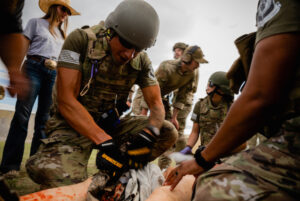
Story by Ricardo Amador
59th Medical Wing
In the not-so-distant future, a U.S. medic may encounter an injured warfighter on a remote battlefield. Instead of drawing a liquid painkiller from a vial using a needle and syringe, they will pull a mini-autoinjector from their bag, activate, and immediately administer to their patient. The medic will be able to ease the warfighter’s pain in seconds instead of agonizing minutes.
This vision for the future became more achievable with Air Force Research Laboratory’s (AFRL) award of two contracts on behalf of the Air Force Medical Readiness Agency (AFMRA).
The contracts, awarded to a medical device innovator, will allow the small business to adapt their auto-injector technology for military applications. The auto-injectors are designed to deliver life-saving medications like epinephrine in a small, key-fob sized unit. With modification, they can be used to administer medications required on a battlefield such as ketamine, hydromorphone, or Tranexamic Acid. U.S. Food and Drug Administration (FDA) approval is required for military applications of this auto-injector, and these contracts serve as a critical step in fielding a safe and effective product for saving lives.
The 59th Medical Wing’s Chief Scientist’s Office (Science & Technology-S&T), Air Force Special Operations Command (AFSOC), and AFMRA teamed up to advocate for the military use of this disruptive, life-saving technology.
Beginning with the military’s use of small disposable syrettes of morphine to treat wounded soldiers’ pain on the battlefield, the military has sought better and safer means to provide care in austere conditions. One solution was an autoinjector that would enable medics to quickly provide predetermined doses of pain medication to wounded warfighters, usually under enemy fire and in austere locations. However, these autoinjectors were too big and bulky to carry downrange, and often resulted in accidental injections to medics.
Then, the 59th MDW was approached by a medical device innovator interested in co-developing their mini-autoinjectors.
“We saw a commercial technology that had the potential to save warfighters’ lives on the battlefield, and dedicated ourselves to find out, and then make it happen,” said Dr. Shelia Savell, 59th Medical Wing nurse scientist.
The S&T team consulted with AFSOC’s Medical Modernization Division, who was interested in adapting the autoinjectors for their medics, and then worked with the medical device innovator to submit a proposal package to AFWERX’s Small Business Innovation Research (SBIR) program.
After a series of successful development projects, the technology was ready for “advanced development,” funded by the award of two more contracts. This stage involves final design, manufacturing, engaging the FDA, and marketing.
The S&T teams says the autoinjector yielded excellent test results with an extended drug shelf-life and effective delivery of critical battlefield medications. They believe the technology is positioned to impact both military and civilian healthcare significantly.
“We are appreciative of AFWERX and other SBIR programs,” said Dr. Scott Walter, S&T’s Director of Technology Transfer. “They enable the military to identify, evaluate, and co-develop mission-essential medical products with small businesses that spin in new ideas and technologies and enhance our military medical capabilities.”
Note: The small business medical device innovator referenced in the article, Rx Bandz, LLC, was awarded contracts in conjunction with the Small Business Innovation Research (SBIR) program, established by U.S. Congress in 1982 to fund research and development. This article is informational only and does not imply Department of Defense endorsement of any company or organization.